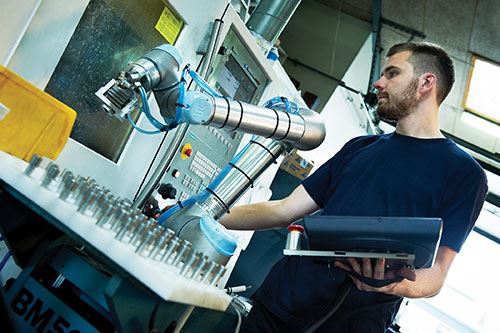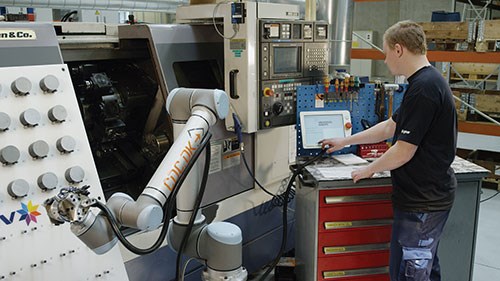Automation without Enclosures
A new line of robot arms can safely function alongside personnel with no safety guarding in many cases.
Share





IMTS 2012 saw the U.S. introduction of Universal Robots’ line of lightweight, six-axis robot arms for machine tending and other automated applications. Perhaps this equipment’s most distinguishing feature is that it often doesn’t require the enclosures that typical robotic loading applications do. Because the robot arms are compliant with the ISO 10218 safety standard for industrial robots, they can safely function alongside personnel with no safety guarding in many cases. If an employee was to contact the robot arm exerting a force of only 150 Newtons, the robot arm would automatically stop operating. (The arm measures electrical current in its joints to determine force and movement, rather than more costly sensor technology.) That said, all companies must carry out a risk assessment of their specific applications, considering how the arms are installed, what gripping tools are used and so on to determine if enclosures are needed.
The Denmark-based company recently hired Edward Mullen as the national sales manager of Universal Robots USA (Wading River, New York). He says three other key benefits of this robot arm design are that it is affordable, simple to program and can be moved easily from spot to spot throughout a facility. The UR5 and UR10 robot arm models can handle payloads of 11.3 and 22.6 pounds, respectively. The UR5 weighs 40.6 pounds and offers a 33.5-inch reach, while the UR10 weighs 63.7 pounds and offers a 51.2-inch reach. Repeatability of ±0.004 inch enables precision handling of even very small parts.
Setup and programming are intuitive, Mr. Mullen says, eliminating the need for highly skilled operators. Users can either guide the robot’s arm to teach it the desired movement or create programs via the control’s 12-inch touchscreen. Simple programming complements the robot arms’ light weight, enabling them to be easily re-deployed and re-programmed for a new task. In addition, affordability enables more small- and medium-sized companies to realize the benefits of unattended machining. According to the company, the average pay-back period is just six months.
Related Content
-
Lean Approach to Automated Machine Tending Delivers Quicker Paths to Success
Almost any shop can automate at least some of its production, even in low-volume, high-mix applications. The key to getting started is finding the simplest solutions that fit your requirements. It helps to work with an automation partner that understands your needs.
-
Same Headcount, Double the Sales: Successful Job Shop Automation
Doubling sales requires more than just robots. Pro Products’ staff works in tandem with robots, performing inspection and other value-added activities.
-
How to Accelerate Robotic Deburring & Automated Material Removal
Pairing automation with air-driven motors that push cutting tool speeds up to 65,000 RPM with no duty cycle can dramatically improve throughput and improve finishing.























